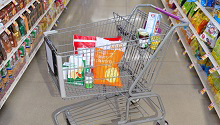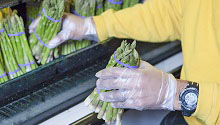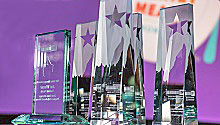"We envision a day when consumers will walk into a store, select products whose packaging is embedded or printed with a microchip that transmits signals, and exit the store without standing in line, visiting a cash register or signing a receipt," said FMI Electronic Payment Systems Committee Chair Jacki Snyder, manager of electronic payment systems at SUPERVALU INC.
Faster Checkout Technology Demonstrated
At the hearing and afterwards, she and a representative from Concord EFS, Inc., demonstrated one of the first steps toward that future in a technology that automatically processes and clears checks. "Anyone who has stood in line behind a slow check-writer can appreciate this technology," Snyder said.
In one system, the customer hands a blank check to the cashier. It is scanned and cleared and returned to the customer, along with the receipt. In another, the shopper uses an automatic clearinghouse (ACH) card issued by the retailer. The card is scanned and the transaction is processed much like a direct debit. A loyalty card, bar-coded key ring or radio frequency wand may also be used in this type of transaction.
Through an alliance with FMI, Concord is making the technology available to all members of the supermarket industry.
Technology to Revolutionize the Checkout Process and Shopping Experience
Snyder emphasized that the new checkout technology is part of a much broader trend that will transform the checkout process and shopping experience. Working with the food industry and others, the Massachusetts Institute of Technology (MIT) developed a semiconductor that can carry an interactive electronic product code (ePC). This microchip can collect and transmit extensive information about the product, its freshness, its location, whether it needs to be replaced, how to cook it and more, along with the information carried by the Universal Product Code (U.P.C.).
The chips communicate by radio signals with microprocessors throughout the grocery supply chain from the manufacturing plant to the store shelf to the shopping cart to the checkout to the customer's kitchen.
The Smart Kitchen
Within the kitchen, such products can offer consumers a wide variety of benefits, which are under development at MIT labs. For example, such smart products can:
- Tell a microwave oven equipped with the appropriate technology how to cook them, including when, how long and at what level.
- Communicate when freshness dates have expired.
- Notify the consumer when they need to be reordered and automatically notifying the supermarket to replenish the supply during the shopper's next visit or online-based delivery.
- Smart coffee makers can tailor the blend to the preferences of different members of the household based on voice commands. In the morning, such appliances can be programmed to present the latest news of interest to individuals.
Barriers to the Future
As futuristic as such capabilities might seem, the technologies to make them available are well developed. The main barriers are cost and standardization, according to Snyder's testimony.
"You may have received complaints from consumers, your state government or grocers about the new EBT (electronic benefit transfer) cards being used to deliver benefits under the Food Stamp program not working properly," she said. "Those cards should work correctly every time, but they do not. Most of the problems being experienced with the EBT cards are caused by the lack of operational standards that are so important to new technologies."
"Several of FMI's members have been looking at smart cards and the need for national and international standards before that technology is embraced. A smart card or chip card should work the same in Alabaster, Alabama, as it does in Eden Prairie, Minnesota, or Beijing, China. Standardization has ensured that credit cards or ATM-debit cards can be used in each of these places and because of that, use has soared."
Snyder also cited the need to reduce the transaction fees charged by banks and credit card associations. She testified that the amount of profit for banks and credit card associations on a customer's order exceeds that of the grocer. Net profits for food retailers average about one penny on every dollar of sales, according to FMI research.
The automatic check-processing systems demonstrated at the hearing can dramatically reduce transaction costs, she said, benefiting both consumers and grocers.
The Internet can help microchip developers overcome the cost barrier, according to MIT. The cost of chips or tags can be reduced to one or two cents each if the information they contain is limited and stored instead at a Web site. The ePC, which MIT unveiled this January, could become the common language for all communications among smart products and systems with the information stored on the Internet.
 Industry Topics address your specific area of expertise with resources, reports, events and more.
Industry Topics address your specific area of expertise with resources, reports, events and more.
 Our Research covers consumer behavior and retail operation benchmarks so you can make informed business decisions.
Our Research covers consumer behavior and retail operation benchmarks so you can make informed business decisions.
 Events and Education including online and in-person help you advance your food retail career.
Events and Education including online and in-person help you advance your food retail career.
 Food Safety training, resources and guidance that help you create a company food safety culture.
Food Safety training, resources and guidance that help you create a company food safety culture.
 Government Affairs work — federal and state — on the latest food industry policy, regulatory and legislative issues.
Government Affairs work — federal and state — on the latest food industry policy, regulatory and legislative issues.
 Get Involved. From industry awards to newsletters and committees, these resources help you take advantage of your membership.
Get Involved. From industry awards to newsletters and committees, these resources help you take advantage of your membership.
 Best practices, guidance documents, infographics, signage and more for the food industry on the COVID-19 pandemic.
Best practices, guidance documents, infographics, signage and more for the food industry on the COVID-19 pandemic.
